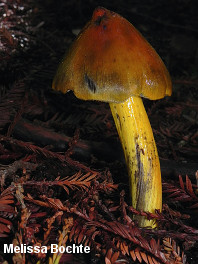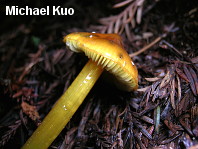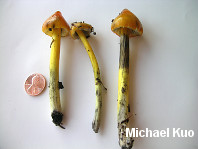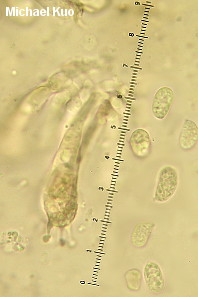| Major Groups > Gilled Mushrooms > Pale-Spored > Waxy Caps > Hygrocybe singeri |

|
Hygrocybe singeri [ Basidiomycota > Agaricales > Hygrocybaceae > Hygrocybe . . . ] by Michael Kuo Hygrocybe singeri is essentially a slimy-stemmed version of Hygrocybe conica. Like its more familiar cousin, Hygrocybe singeri discolors black and has a brightly colored, conical cap. But while the stem of Hygrocybe conica is dry or faintly greasy, the stem of Hygrocybe singeri is truly slimy, making it difficult to pick. The species as it is currently defined has a "disjunctive distribution" that is "interesting and peculiar" (Hesler & Smith, 1963); it is known from South America, Central America, and Mexico--and from northern California and the Pacific Northwest, and from Michigan and the upper Great Lakes. Hygrophorus singeri is a synonym. Hygrocybe singeri var. albifolia is a putative variant that differs in having white immature gills and in lacking clamp connections. However, the young gills of the typical variety can appear whitish, and the only known collection of var. albifolia is in such bad shape that "the apparent absence of clamps could be a failure to find them due to the condition of the material" (Hesler & Smith, 1963). Description: Ecology: Precise ecological role uncertain (see Lodge and collaborators, 2013); appearing under conifers; usually growing scattered; spring through fall, or over winter in warmer climates; recorded from California, the Pacific Northwest, Michigan, and Mexico. The illustrated and described collections, from northern California, were made under coast redwood. Cap: 1-3 cm; conic, becoming broadly conic; thickly slimy when fresh; bald; reddish orange to orange or deep orangish yellow; blackening with age or when bruised; very finely lined near the margin when mature. Gills: Narrowly attached to the stem; close or nearly distant; whitish to pale orangish yellow; slowly blackening when bruised. Stem: 5-14 cm long; up to 1 cm thick; equal; slimy; finely grooved lengthwise; orangish yellow to yellow; blackening with age or when bruised; white at the base. Flesh: Thin; yellowish; watery; blackening. Odor and Taste: Not distinctive. Spore Print: White. Microscopic Features: Spores 8-11.5 x 5-6.5 µ; smooth; ellipsoid, or occasionally slightly constricted and irregular; hyaline in KOH; inamyloid. Basidia 4-sterigmate; 40-60 µ long. Hymenial cystidia absent. Lamellaer trama parallel. Pileipellis a thick gelatinous layer. Clamp connections present. REFERENCES: (Smith & Hesler, 1954) Singer, 1958. (Hesler and Smith, 1963; Largent, 1985.) Herb. Kuo 01160502, 01121103. This website contains no information about the edibility or toxicity of mushrooms. |
© MushroomExpert.Com |
|
Cite this page as: Kuo, M. (2014, March). Hygrocybe singeri. Retrieved from the MushroomExpert.Com Web site: http://www.mushroomexpert.com/hygrocybe_singeri.html |



